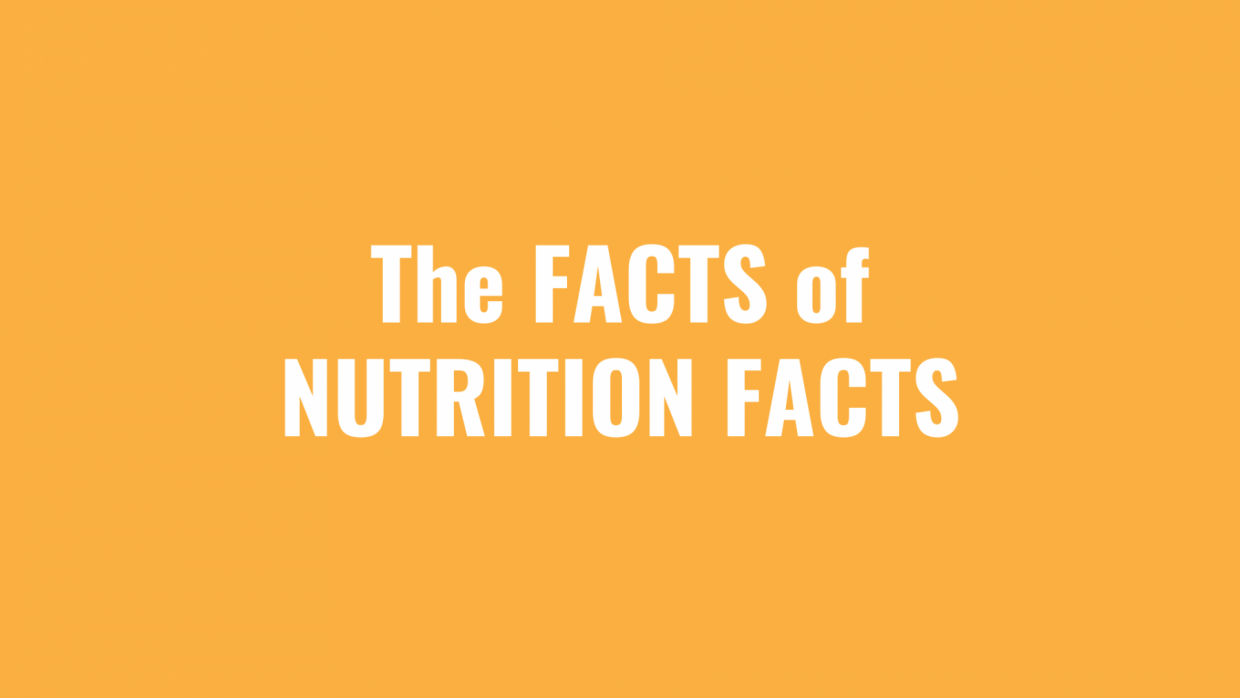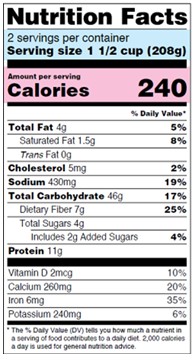Nutrition Facts Label

What is the Nutrition Facts Label?
Every packaged or processed food should have a label; this white box can be found on the back or side of food packages. You will see the title, "Nutrition Facts", followed by key information about the food. The amount of nutrients, like calories, fat, sugar, fiber, and sodium are just a few items you will find on the label. They are listed per serving and as a percentage of the daily value.
 Find a Nutrition Facts Label on a food in your home to follow along with the information below!
Find a Nutrition Facts Label on a food in your home to follow along with the information below!
Calories- Despite all the talk about carbs and fat, calories are what counts for weight control. The first thing to look for on a label is the serving size. You can then find the number of calories per serving.
Serving Size and Number of Servings Per Container- The serving size reflects the amount that people typically eat or drink. It is not a recommendation of how much you should eat or drink. It’s important to realize that all the nutrient amounts shown on the label, including the number of calories, refer to the size of ONE serving. Pay attention to the serving size, and especially to how many servings there are in the food package.
Dietary Fiber- Fiber helps fill you up, and you need at least 25 grams of fiber daily. To be considered high in fiber, a food must contain at least 5 grams per serving. Fruits, vegetables, and whole grains always provide fiber.
Fat, Sodium, & Sugar-
- Fats, like oils and butter, have 9 calories per 1 gram of fat. Try to limit foods with saturated and trans fats (also called trans fatty acids)- these fats can be food on under "Total Fat" on the label.
- Sodium should be limited to 2,300 mg per day (that is less than 1 teaspoon of salt) for healthy adults and limited to 1,500 mg per day for those with health concerns or family histories of high blood pressure. To reduce your sodium intake, choose less processed foods or find lower sodium versions of packaged foods.
- Sugar adds plenty of calories and is often listed in the Ingredient List in code words, like "high fructose corn syrup," "dextrose," "invert sugar,” etc. Choose foods with less than 5 grams Added Sugar per serving to help control calories. Added Sugars can be found under "Total Sugars" on the food label.
% Daily Value (%DV)- This reflects the percentage of a certain nutrient that the food supplies; it is based on a 2,000-calorie diet. 5% or less of a nutrient is LOW while 20% or more is HIGH. For sodium, saturated fat, and added sugar, look for foods with a DV of 5% or less. For vitamins, minerals, and fiber, look for foods with a DV of 20% or more.
What Is the Ingredient List?
The Ingredient List is often found under the Nutrition Facts Label on the food package. Manufacturers are required to list all the ingredients contained in the food product by weight. For example, a jar of tomato sauce with tomatoes as the first ingredient lets you know that tomatoes are the main ingredient. The spice or herb listed last is contained in the least amount. While all the ingredients are important, we often focus on the first few ingredients listed because they make up the bulk of that food.
Let's Be Social...
Interested in learning more nutrition tips, collecting new recipes, and learning more information about Beyond Hunger's services?